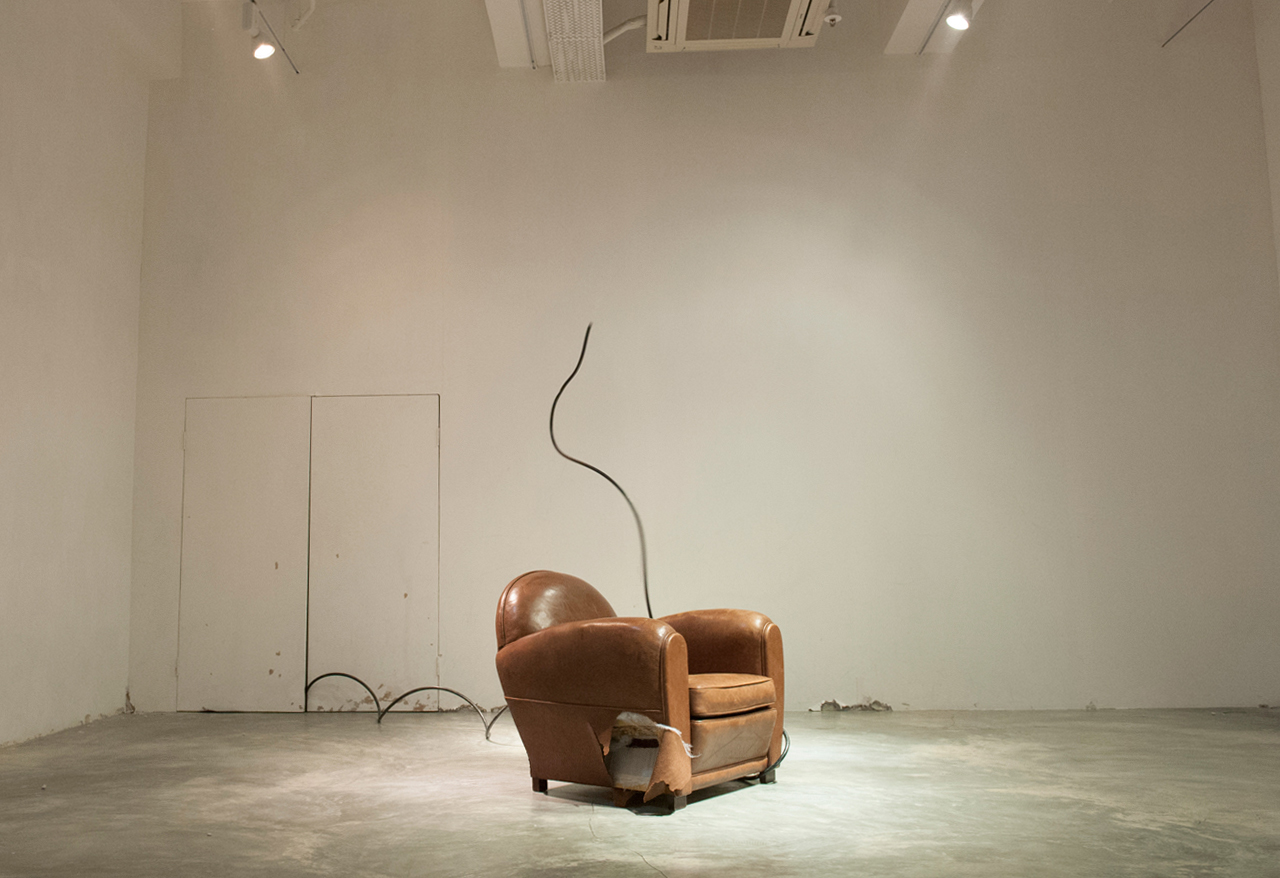Shows
Sun Yuan & Peng Yu and Jin Shan: “Dear, Why Freedom”


A disconcerting hissing noise echoes off the walls in Platform China’s current exhibition “Dear, Why Freedom,” producing an unsettling, almost adversarial atmosphere in the remote Chai Wan gallery. Immediately upon entering the space, an onslaught of wild, hectic movements puts one on edge. A thin, black rubber hose releasing spurts of pressurized air performs a disturbing dance around an old leather armchair, inadvertently—or deliberately—tearing off the armrest's fabric while demolishing parts of the cement floor and nearby wall. Between intervals of the hose’s flailing struggle against its restraints, the isolated chair appears to offer a place of rest—even or a moment—until it is consumed again by the abrupt, violent spasms of the hose.
The installation, entitled Dear (2013), by artist-duo Sun Yuan and Peng Yu, is one of only two artworks presented in the exhibition. In combination with Jin Shan’s seven-channel video, Why Freedom (2014), the show brings together two different ways of engaging with notions of freedom and control.



The Beijing-based Sun and Peng are particularly well-known for their extreme use of (live) materials. Body Link (2000), for example, is of comprised a staged blood transfusion using the dead fetus of conjoined twins, while Safe Island (2003) features a cage full of spectators circled by a real-life tiger, which creates an inverse experience of visiting a zoo. In recent performance installations, Sun and Peng have substituted their organic mediums with synthetic materials to further their investigations of spatial transformation. Stemming from this, Dear articulates the notion of space and, at the same time, tests the limitations of freedom—a concept that ultimately has its own limitations. In simulating a confined but kinetic and willful form that undergoes schizophrenic agitation, the installation alters the perception of “free” space and, in turn, limits the visitor’s physcial and emotional experience around the objects.
In an attempt to escape the tense environment induced by Dear, one turns toward the series of videos presented by Jin Shan. Yet Why Freedom fails to provide relief with its disturbing filmic approach towards notions of intimacy and psychological control. Shot in late August 2014, it portrays a couple invited by Jin to partake in a sadomasochistic project over several days in the artist’s studio. Six small screens on the exhibition wall expose the undressed, shackled man and woman in various submissive positions, waiting obediently for the artist’s commands. From toe-sucking to being aggressively hosed down by the artist, the masked strangers perform numerous festishistic tasks over the course of two days. In addition to setting uncomfortably high camera angles—resembling the perspective of surveillance videos—the artist also took close-range pictures, sometimes while being performed upon by the couple. These photos were exhibited in Platform China’s booth at Art Basel Hong Kong this past March.
Jin explicitly crosses the line between public and private narration in this performance. The work can be interpreted as an evolved form of “One Man’s Island” (2009–10), a long-term project where he endured self-imposed solitary confinement in his studio, which resulted in a collection of videos that captured his various mundane acts during this time. In Why Freedom, through the film on its seventh screen, Jin himself negates the work’s status as art and talks at length about his cynical view of curated exhibitions.
Sun and Peng's construction of frantic hose movements reminiscent of a slashing whip, and the visually confrontating sexual power-play orchestrated by Jin keep one at arm’s length with both Dear and Why Freedom. Oscillating between absolute physical repulsion and an innate sensation of distressing curiosity, the audience’s psychological tolerance is tested throughout the exhibition. Watching the intimate acts of sexual obedience in Jin's work, viewers are left to consider their own mischievous involvement in the artist’s private activities. This voyeuristic implication, enhanced by a general discomforting ambience in the gallery space, challenges the visitor’s perception of contemporary morality and reflects on the paradoxical prerogative of consensual sexual captivity in today's "free" society.
“Dear, Why Freedom” is on view at Platform China, Hong Kong, until May 10, 2015.







